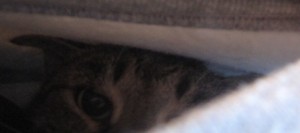A blog reader (thank you soooo soooo much!) translated the cat-relevant part of the 2003 Swedish study, Purr as a cat–and avoid osteoporosis, which I mentioned in my recent cat purring/bone healing post. Fabulous! So today I am going to post a quick update containing most of his translation. I have highlighted (in bold) a few of the more important, in my opinion, passages:
WHY do cats have such strong bones and so rarely bone defects and fractures compared with dogs? According to new evidence and theories, it is their purring which seems to be healing and strengthening for bone tissue. Purring provides vibrations which stimulate bone cells.
The cat achieves its purring via nerve pulses to the musculature of the throat and abdomen, according to A. L. Lyons, veterinarian at the University of California, Davis. In doing so, it sets an elastic sinew, between the clavicle and the windpipe, in vibration. The sinew vibrates at both inhalation and exhalation of the domestic cats according to a fixed pattern and frequency. Variations in frequency range between 25-150 hertz, and cats can vary the strength of their purr. Among big cats, however, the vibrations are limited to exhalation. The frequency range is especially interesting because it corresponds well with the frequencies that researchers in animal experiments have found can stimulate bone density and the healing of fractures.
Cats are hunters and strongly dependent on speed and strength of muscles and skeleton. The cheetah, the fastest land animal on Earth, creeps up slowly on its prey and then accelerates lightning-fast to speeds that can approach 100 km per hour, then it strikes down its quarry within about 20 seconds. The final hunting phase rarely lasts more than a minute.
An animal weighing between 40 and 65 kg can make bring down a catch of up to 40 kg. But it eats an average of under 3 kg of meat a day. Therefore, its life on the savannah consists largely of lying still – the greatest risk factor for osteoporosis and muscle atrophy! The small amount of physical activity these quadrupeds normally expose their bones and muscles to in their survival on the savannah is hardly sufficient for them to be in the highest trim.
But purring is a mechanism that requires small amounts of energy and yet can still stimulate muscles and bone to strength and explains the cat’s performance ability despite the low level of exercise [=my Puzzola in this recent photo]. Perhaps it can also provide the background to the proverb that the cat has nine lives, as the purr vibrations should facilitate the healing of fractures and other tissue damage in reference to what has been shown in animal experiments in the laboratory environment.
Perhaps it can also provide the background to the proverb that the cat has nine lives, as the purr vibrations should facilitate the healing of fractures and other tissue damage in reference to what has been shown in animal experiments in the laboratory environment.
Obviously, it is tempting to argue that cats purr for them to feel satisfied, but it’s more likely that their purring is partly a way for them to communicate and that it is also a potential source of self-healing and strengthening of the muscles and skeleton.
[…] Maria Sääf at the Karolinska Hospital in Stockholm, who has long studied the issues surrounding osteoporosis, […] was very enthusiastic about the possibility that vibration could also be beneficial for people with osteoporosis. A couple of pieces fell into place when she told me how vibrations are already being used in sports medicine to stimulate healing processes for injured elite athletes and that there is a new prototype machine at a school for children with limited movement which actually works with vibration technology. Her database search gave many hits of studies of the effects of vibrations on bone strength in animal experiments. But unfortunately there was a lack of work with results from human trials.
My reader/Swedish translator told me about a purring 2003 “Scientific American” article. I looked it up: http://www.sciam.com/article.cfm?id=why-do-cats-purr And, while reading it, I remembered that all of my cats purred like mad after they had been “fixed.” At the time, I thought that they were simply happy to be home. How silly of me! Now their purring makes more sense: they were healing themselves, and, in fact, I bet that their purring helped alleviate the pain that they must have been feeling, poor dears.
The SciAm article confirms that purring corresponds to sound frequencies that have been shown to improve bone density and promote healing. And, interestingly, both the Swedish study and the SciAm article discuss the fact that cats do not display as many muscle and bone abnormalities as their more strongly selected carnivore relative, the domestic dog. Perhaps cats’ purring helps alleviate the dysplasia or osteoporotic conditions that are more common in their canid cousins.
So snuggle up to your cat or cats, as I have been doing more and more lately. Let me warn you that snuggling could have unfortunate consequences. You see, now, every time I sit or lie down during the day,  Priscilla demands in no uncertain terms to get under my sweater (see photo: so far, this is the best shot I have been able to get of her under my sweatshirt). Ignoring her is not an option. And her insistence can get to be a real drag when I am busily typing or reading. But then I think about my bones and how her purring may prevent future problems for me…
Priscilla demands in no uncertain terms to get under my sweater (see photo: so far, this is the best shot I have been able to get of her under my sweatshirt). Ignoring her is not an option. And her insistence can get to be a real drag when I am busily typing or reading. But then I think about my bones and how her purring may prevent future problems for me…